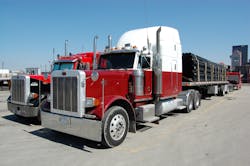TL rates are projected to jump between 3% and 5% this year, with LTL rates increase 3% 4% as well, according to projections issued by John Larkin, managing director & head of transportation capital markets research for Wall Street investment firm Stifel Nicolaus & Co., during a webinar presentation this week.
Hosted by Logistics Management magazine, the panel of industry experts participating in the webinar – entitled Where are transportations rates headed in 2015? – believe that freight rates for all modes will witness increases this year except for ocean carriers and U.S. domestic intermodal providers.
Brooks Bentz, a former partner with Accenture’s supply chain management practice, noted that domestic intermodal rates in some segments may actually decrease slightly in 2015 as providers try to recapture market share lost to TL carriers due in large measure to plummeting diesel prices.
“The drop in diesel prices has dampened the fuel leverage advantage intermodal traditionally has had over TL carriers,” he explained. “That’s shifted some [freight] business back to over-the-road carriers.”
That’s also why intermodal rates only increased overall at about half the amount as pure rail carload rates in the fourth quarter last year, Bentz added.
Charles Clowdis, managing director of transportation advisory services for consulting firm IHS Global Insight, emphasized that shippers should not expect low oil prices to find their way into freight rates this year.
“Don’t count on windfall savings from low fuel prices,” he stressed.
And while Clowdis focused his presentation on the air freight market – where revenues are expected to increase 4.5% this year due to higher rates – he pointed out that all modes need to monitor ocean port congestion and labor issues on the U.S. west coast closely.
“Be very vigilant about port selection because the labor unrest [at the ports of Los Angeles and Long Beach] is not nearly settled,” he warned.
For trucking, Larkin’s Stifel said port congestion is only one of several major challenges facing the industry near term – challenges that he expects will eventually blow up into the “mother of all capacity shortages” in the 2017-2018 time frame.
“Trucking carriers roughly two-thirds of all U.S. tonnage and the industrial portion of that tonnage was quite strong in 2014 and seems poised to continue in 2015,” he said. “But by the same token retail demand has been sluggish so at some point you have to ask will industrial [freight] demand stay strong if retail continues to soften?”
Larkin noted, too, that highway congestion and the general state of despair of the nation’s roadway network will affect truck capacity availability as well.
He also added that the driver shortage is now “universal” in trucking; affecting not just irregular route long-haul TL carriers but private fleets, drayage companies and even LTL companies.
“They’ve all been trying every technique in the book” to recruit more drivers, he said, but “they are not working well.”
Though the rollback of the 34-hour restart provision by Congress should generate a 2% boot in TL productivity this year, a “laundry list” of new rules in the “regulatory pipeline” over the next two to three years will result in further cuts to both trucking capacity and productivity, Larkin stressed.
In particular, he said mandates for electronic logging devices (ELDs) and speed limiters will impact the industry the most. “Anywhere from one-third to half of all trucking carriers violate hours of service (HOS) rules to survive,” Larkin pointed out.
The resulting crimp in trucking capacity and productivity from eliminating all of that may ultimately “regulate industrial production downward,” he said – which would end up “containing U.S. economic growth.”
About the Author
Sean Kilcarr
Editor in Chief
Sean Kilcarr is a former longtime FleetOwner senior editor who wrote for the publication from 2000 to 2018. He served as editor-in-chief from 2017 to 2018.
